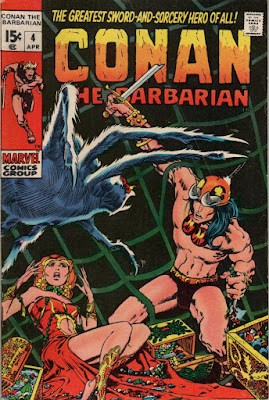The Lair of the Beast-men (Conan #2)
In Conan the Barbarian: Lair of the Beast-Men, we see Conan kneeling over the corpse of a giant Beast-Man while traversing Aesgaard, only to be lured into an ambush by Moira, a mysterious woman. Captured by brutish ape-men, he is dragged to Brutheim, an underground kingdom where humans, known as "manlings," live enslaved. Befriending Kiord, the Chief Thrall, Conan learns of the hopelessness that pervades the enslaved people. Thrown into the arena as entertainment for the Beast-Men's king, Gha-Kree, Conan refuses to succumb. He kills a savage snow-lion in combat, inspiring Kiord and the manlings to revolt. The uprising spreads chaos, culminating in a battering ram smashing the arena's pillars. Though Kiord is slain by King Zha-Gorr, Conan avenges him and crowns Kiord "First among men," symbolizing the reclamation of humanity's dignity and strength from their oppressors. The rebellion marks the fall of the Beast-Men’s dominion and underscores Conan’s defiance against tyranny.
Theme:
The central theme is freedom versus slavery, as Conan resists physical and ideological bondage in a harsh, alien environment. This is conveyed through Conan’s defiant nature, his refusal to accept enslavement, and his ultimate triumph in a society that values submission.
Author's Style:
The style is vivid and dramatic, rich with descriptive language and intense action. Phrases like “Great swordlike spires, straining upward to fence with stalactite spears” create a fantastical and ominous tone.
Tone:
The tone is serious and epic, fitting for a heroic tale. There’s an undercurrent of tragedy in the plight of the slaves but also hope in Conan’s resilience.
Character Development:
- Conan: Presented as resourceful, strong-willed, and fearless, he symbolizes unyielding freedom and defiance against oppression. His actions are motivated by survival and an innate disdain for tyranny.
- Kiord: A tragic figure, Kiord’s resignation to servitude contrasts sharply with Conan’s defiance, highlighting the effects of prolonged oppression.
Character Relationships:
- Conan’s interaction with Kiord emphasizes the ideological clash between freedom and submission.
- Moira’s and Zhagorr’s relationships with Conan reveal betrayal and antagonism, with Moira luring him into a trap and Zhagorr treating him as a trophy.
Character Symbolism:
- Conan: Represents unrelenting human spirit and resistance.
- Kiord: Embodies the resigned acceptance of slavery and the tragedy of lost potential.
Plot Structure:
- Exposition: Conan’s struggle against the elements and initial encounter with Moira and the beastmen.
- Rising Action: His capture and introduction to Brutheim.
- Climax: Conan’s trial by combat against the snow lion.
- Resolution: Triumph over the lion, setting the stage for further rebellion.
Conflict:
The central conflict is Conan’s struggle for freedom against the beast-men. This extends to a thematic conflict between freedom and oppression.
Symbolism:
- Chains: Represent the physical and mental bondage of the slaves.
- Snow lion: A natural challenge and symbol of Conan’s triumph over unnatural oppression.
Social Setting:
- A brutal, hierarchical society ruled by beast-men, with humans reduced to slaves. The stark inequality mirrors the broader theme of oppression.
Setting's Significance:
The setting heightens the stakes of Conan’s struggle, with Brutheim serving as a microcosm of tyranny.
Interpretation:
The story portrays the indomitable spirit of humanity against overwhelming odds. Conan’s resistance and triumph symbolize hope and defiance.






Comments
Post a Comment